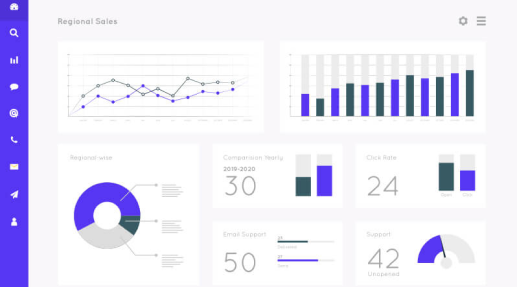Predictive Analytics
This service is highly valuable as it helps businesses forecast future trends, patterns, and outcomes based on historical data. It enables proactive decision-making, risk management, and strategic planning.
Data Visualization
This service is highly valuable as it helps businesses forecast future trends, patterns, and outcomes based on historical data. It enables proactive decision-making, risk management, and strategic planning.
Data Collection and Integration
This service is highly valuable as it helps businesses forecast future trends, patterns, and outcomes based on historical data. It enables proactive decision-making, risk management, and strategic planning.
Process For Data Analytics
Process For Data Analytics Typically Include the Following Steps :
01
Data Collection And Integration:
Gathering data from various sources such as databases, sensors, social media, and other sources, and integrating it into a unified dataset.
02
Data Cleaning and Preprocessing:
Identifying and handling missing values, outliers, and inconsistencies in the data to ensure its quality and reliability for analysis.
03
Descriptive Analytics:
Summarizing and describing the characteristics of the data through metrics, charts, and graphs to understand patterns and trends.
04
Diagnostic Analytics
Analyzing data to understand why certain events or patterns occurred, often using techniques like root cause analysis and correlation analysis.
05
Predictive Analytics:
Building predictive models using statistical and machine learning algorithms to forecast future trends and outcomes based on historical data.
06
Prescriptive Analytics:
Recommending actions and strategies based on predictive models and business objectives, helping organizations make data-driven decisions.
07
Data Visualization:
Creating visual representations of data using charts, graphs, dashboards, and interactive tools to communicate insights effectively.
08
Text and Sentiment Analysis:
Analyzing unstructured text data from sources like social media, customer reviews, and surveys to extract sentiment, themes, and patterns.
09
Big Data Analytics:
Handling and analyzing large volumes of structured and unstructured data using technologies like Hadoop, Spark, and NoSQL databases.
10
Data Governance and Security:
Ensuring data quality, security, compliance with regulations, and establishing policies and procedures for data management.
Why Data Analytics Is Important
There are some points to understand Why Data Analytics Is Important :
1. Informed Decision Making: Data analytics helps businesses make informed decisions by providing insights based on data-driven analysis. It enables organizations to understand trends, patterns, and correlations in their data, leading to better strategic planning and resource allocation.
2. Improved Efficiency and Effectiveness: By analyzing data, businesses can identify inefficiencies, bottlenecks, and areas for improvement in processes, operations, and performance. This optimization leads to increased efficiency, reduced costs, and enhanced productivity.
3. Customer Understanding: Data analytics allows businesses to gain a deeper understanding of their customers' behavior, preferences, and needs. This information helps in segmenting customers, personalizing marketing campaigns, improving customer experiences, and fostering customer loyalty.
4. Risk Management: Data analytics helps in identifying and mitigating risks by analyzing historical data, predicting potential risks and trends, and developing risk management strategies. It enables businesses to make proactive decisions to minimize risks and maximize opportunities.
5. Competitive Advantage: Businesses that leverage data analytics gain a competitive advantage by staying agile, responsive, and innovative. They can identify market trends, competitive threats, and emerging opportunities faster than their competitors, leading to market differentiation and growth.
6. Performance Monitoring: Data analytics enables real-time monitoring and tracking of key performance indicators (KPIs), business metrics, and operational metrics. It helps in measuring progress, identifying deviations from targets, and taking corrective actions promptly.
7. Product and Service Optimization: By analyzing customer feedback, usage data, and market trends, businesses can optimize their products and services to better meet customer expectations, improve quality, and drive innovation.
8. Predictive Insights: Advanced analytics techniques such as predictive analytics and machine learning enable businesses to forecast future trends, customer behavior, and business outcomes. This foresight empowers businesses to make proactive decisions and seize opportunities ahead of time.
9. Compliance and Governance: Data analytics plays a crucial role in ensuring compliance with regulations, industry standards, and data governance policies. It helps in monitoring data quality, security, privacy, and regulatory compliance, reducing risks of non-compliance and penalties.
10. Continuous Improvement: Data analytics supports a culture of continuous improvement by providing feedback loops, performance metrics, and insights for ongoing evaluation, learning, and optimization across all aspects of the business.
Data Analytics Frequently asked questions
-
01
What is the role of data analytics?
Data analytics helps individuals and organizations make sense of data. Data analysts typically analyze raw data for insights and trends. They use various tools and techniques to help organizations make decisions and succeed.
-
02
What are the types of data analytics?
There are various types of data analysis including descriptive, diagnostic, prescriptive and predictive analytics. Each type is used for specific purposes depending on the question a data analyst is trying to answer. For example, a data analyst would use diagnostic analytics to figure out why something happened.
-
03
What are the analytical tools used in data analytics?
There are various tools used in data analysis. Some data analysts use business intelligence software, such as Tableau. Others may use programming languages such as SQL or Python, which have various statistical and visualization libraries.
-
04
What is the career growth in the data analytics field?
There is not much career data specific to data analysts, but they fall within the same category as data scientists. According to the U.S. Bureau of Labor Statistics, the projected growth for data scientists is 35% between 2022 and 2032External link:open_in_new. The same data shows that data scientists earned a median salary of $103,500 in 2022. However, salary compensation for data analysts varies depending on where they work and what industry they work in.
To make requests for further information, contact us
-
Contact Number
+00(1) 123 456 7890
-
Our Mail
infotechmax@ourmail.com
-
Our Location
New ipsum dolor amet, eiusmod adipisicing 147 New Yors, NY Adipisicing 123

